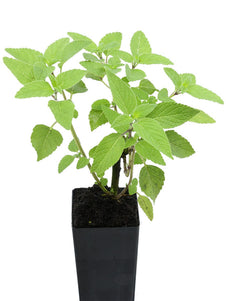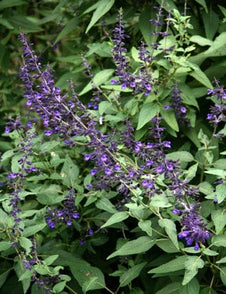



Salvia 'Anthony Parker'
Salvia 'Anthony Parker'

- Low stock - 15 items left
- Inventory on the way

Usually available: All year
Life cycle: Perennial
Height: 1.2 - 1.5m
Position: Sun / part shade
Soil preference: Well drained
This is how we pack and send your Herb Plants to all states except TAS & WA
You will receive
- 1 Salvia Anthony Parker Herb Plant in a 50 X 75mm tube - General growing instructions
All of our Herb Plants are grown organically with certified organic potting mixes and fertilizers
Botanical Name: Salvia leucantha x elegans 'Anthony Parker'
Salvia Anthony Parker grows to 1.2 meter high with a 1.4 meter spread, although it does have a compact and dome shaped appearance. It is considered to be very fast growing and very hardy, with a spectacular flower show. The indigo-blue flowers provide a floral display from late spring and continue to through autumn. They have a dark, inky blue calyx, sitting below the flower on tall spikes, providing a stunning contrast against the grey-green foliage. The flower spikes have downy white hairs and are nearly 60 cm long.
Anthony Parker appears to have appeared as a spontaneous hybrid between Mexican Sage (Midnight Blue) and Pineapple Sage. It was discovered by Frances Parker, in her South Carolina garden in 1994 and named for her grandson. The grey-green leaves are broad and taper to a point, similar to Pineapple sage and they have some veins. Of course, they lack the fragrance of the parent plant. The flowers owe their beauty and tall floral spikes to the Mexican Sage variety ‘Midnight Beauty’, but have a narrower appearance and more blue colouring. There is no doubt that they make wonderful fresh flowers.
Anthony Parker is a highly recommended ornamental garden plant with bee and bird attractant qualities.
Growing Conditions
Salvia Anthony Parker requires full sun or part shade and is quite fast growing. It grows well in free draining soils and is quite tolerant of dry soils once it has become established. It will require deep watering initially to establish the root system and when it is very hot during summer. It may be fertilised in spring, but is quite low maintenance and easy to grow. The flowering period is from late spring or midsummer to autumn, which is a shorter period than some of the other salvias. The plant will respond well to pruning of about half the plant height, after the main flowering months. Old stems can be removed in late spring to encourage new growth.
The salvia family has over 900 members with an extensive history as culinary, medicinal and ornamental plants. Ornamental salvias have become collectors’ items, as gardeners try to find a place in their garden for each and every one. There are salvias that will suit every type of soil and climate. More information on the Salvia genus and Common Sage (Salvia officinalis) may be found on our Common Sage page.
All information provided on this website is for informational purposes only. Please seek professional advice before commencing any treatment.






